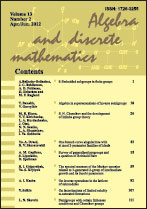|
|
Algebra and Discrete Mathematics, 2005, Issue 1, Pages 8–29
(Mi adm286)
|
 |
|
 |
This article is cited in 4 scientific papers (total in 4 papers)
RESEARCH ARTICLE
Gorenstein matrices
M. A. Dokuchaeva, V. V. Kirichenkob, A. V. Zelenskyb, V. N. Zhuravlevb
a Departamento de Matematica Univ. de SãoPaulo, Caixa Postal 66281, São Paulo, SP,
05315–970 — Brazil
b Faculty of Mechanics and Mathematics,
Kiev National, Taras Shevchenko Univ.,
Vladimirskaya Str., 64, 01033 Kiev, Ukraine
Abstract:
Let A=(aij) be an integral matrix. We say that A is (0,1,2)-matrix if aij∈{0,1,2}. There exists the Gorenstein (0,1,2)-matrix for any permutation σ on the set {1,…,n} without fixed elements. For every positive integer n there exists the Gorenstein cyclic (0,1,2)-matrix An such
that inxAn=2.
If a Latin square Ln with a first row and first column (0,1,…,n−1) is an exponent matrix, then n=2m and Ln is the Cayley table of a direct
product of m copies of the cyclic group of order 2. Conversely, the Cayley table Em of the elementary abelian group Gm=(2)×…×(2) of order 2m is a Latin square and a Gorenstein symmetric matrix with first row (0,1,…,2m−1) and
σ(Em)=(123…2m−12m2m2m−12m−2…21).
Keywords:
exponent matrix; Gorenstein tiled order, Gorenstein matrix, admissible quiver, doubly stochastic matrix.
Received: 17.02.2005
Revised: 29.03.2005
Citation:
M. A. Dokuchaev, V. V. Kirichenko, A. V. Zelensky, V. N. Zhuravlev, “Gorenstein matrices”, Algebra Discrete Math., 2005, no. 1, 8–29
Linking options:
https://www.mathnet.ru/eng/adm286 https://www.mathnet.ru/eng/adm/y2005/i1/p8
|

| Statistics & downloads: |
| Abstract page: | 203 | | Full-text PDF : | 80 | | References: | 5 | | First page: | 1 |
|




 Contact us:
Contact us: Terms of Use
Terms of Use
 Registration to the website
Registration to the website Logotypes
Logotypes









 Citation in format
Citation in format 
